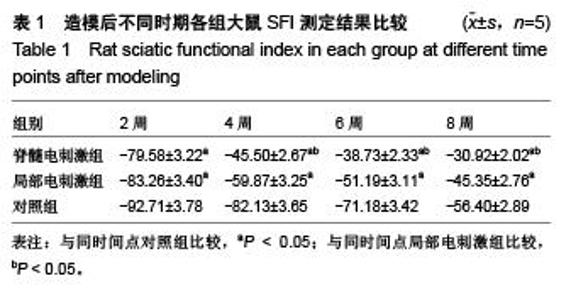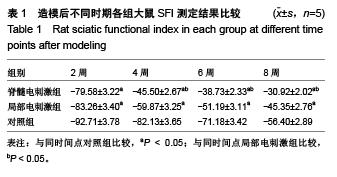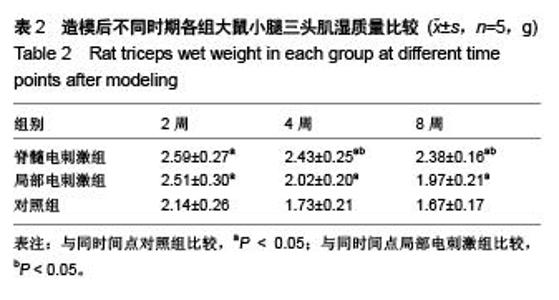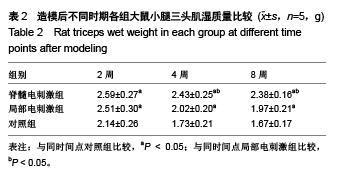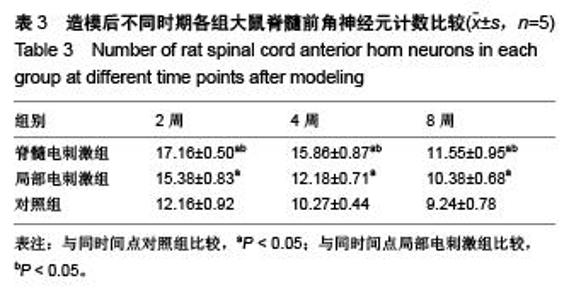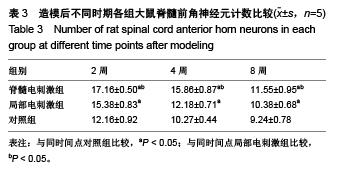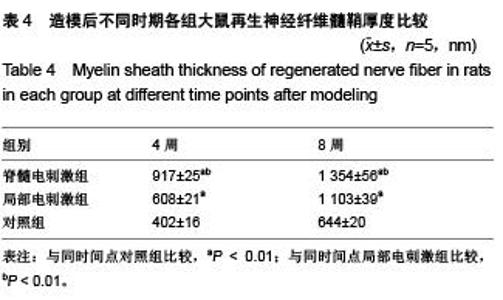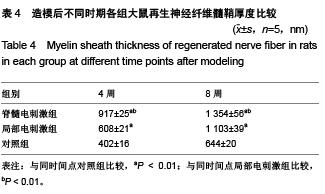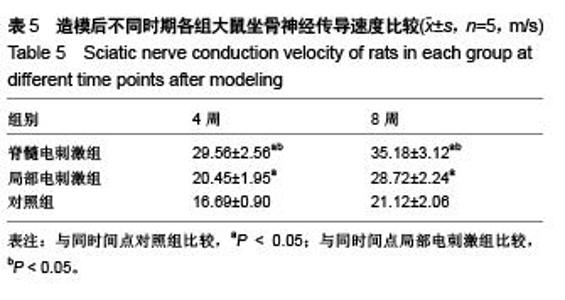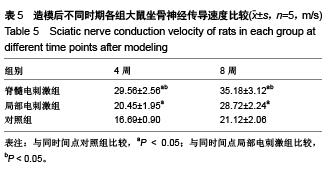Chinese Journal of Tissue Engineering Research ›› 2015, Vol. 19 ›› Issue (49): 7982-7987.doi: 10.3969/j.issn.2095-4344.2015.49.019
Previous Articles Next Articles
Establishing rat models of sciatic nerve injury: repair effect of spinal cord electrical stimulation versus local nerve electrical stimulation
Pei Bao-an1, Zi Jin-hua1, Wu Li-sheng1, Zhang Cun-hua1, Chen Yun-zhen2
- 1Second Department of Trauma, Linyi People’s Hospital, Linyi 276000, Shandong Province, China; 2Qilu Hospital of Shandong University, Jinan 250012, Shandong Province, China
-
Received:2015-09-07Online:2015-11-30Published:2015-11-30 -
Contact:Wu Li-sheng, Master, Chief physician, Master’s supervisor, Second Department of Trauma, Linyi People’s Hospital, Linyi 276000, Shandong Province, China -
About author:Pei Bao-an, Studying for doctorate, Attending physician, Second Department of Trauma, Linyi People’s Hospital, Linyi 276000, Shandong Province, China -
Supported by:the Science and Technology Research Project of Linyi City, China, No.201313026
CLC Number:
Cite this article
Pei Bao-an, Zi Jin-hua, Wu Li-sheng, Zhang Cun-hua, Chen Yun-zhen. Establishing rat models of sciatic nerve injury: repair effect of spinal cord electrical stimulation versus local nerve electrical stimulation[J]. Chinese Journal of Tissue Engineering Research, 2015, 19(49): 7982-7987.
share this article
| [1] 丁小衍,刘小林,刘育杰,等. 去细胞同种异体神经修复材料临床应用初步报告[J].中华显微外科杂志,2009,32(6):448-450.[2] Jiang B,Zhang B, Zhang D,et al. Study on small gap sleeve bridging peripheral nerve injury. Artif Cells Blood Substit Immobil Biotechnol.2006;34(2):55-74.[3] Zhang ZL,Xin L,Song JZ,et al. Bridging peripheral nerves using a deacetyl chitin conduit combined with short term electrical stimulation. Neural Regen Res. 2014;9(10): 1075-1078.[4] Zhivolupov SA, Odinak MM,Rashidov NA, et al. Impulse magnetic stimulation facilitates synaptic regeneration in rats following sciatic nerve injury. Neural Regen Res. 2012; 7(17): 1299-1303.[5] Brodal A. Neurological anatomy in relation to clinical medicine. 3rd ed. USA: Oxford University Press, 1981: 1-32.[6] Chen MH, Ren QX, Yang WF, et al. Influences of HIF-lα on Bax/Bcl-2 and VEGF expressions in rats with spinal cord injury. Int J Clin Exp Pathol. 2013; 6(11): 2312-2322.[7] Preyat N, Rossi M, Kors J, et al. Intracellular nicotinamide adenine dinucleotide promotes TNF-induced necroptosis in a sirtuin-dependent manner. Cell Death Different. 2015; 10(4): 367-374.[8] Lu XM,Shu YH,Qiu CH,et al. Protective effects and anti-apoptotic role of nerve growth factor on spinal cord neurons in sciatic nerve-injured rats. Neurol Res. 2014;36(9): 814-823. [9] 崔红岩,谢小波.脊髓硬膜外电刺激的数学模型[J].中国生物医学工程学报,2008,27(1):61-69.[10] Rattay F,Minassian K,Dimitrijevic MR. Epidural electrical stimulation of posterior structures of the human lumbosacral cord:2.quantitative analysis by computer modeling. Spinal Cord. 2000;38(8):473-489.[11] Chiba A, Nakanishi H, Hiruma S, et al. Magnetieally induced motor evoked potentials and H-reflex during nembutal and ketamine anesthesiaadministration in rats. Res Commun Mol Pathol Pharmacol. 1998;101:43-57. [12] 王熠钊,徐江,黄晓林,等.硬膜外脊髓电刺激电压及频率变化对正常大鼠脊髓反射的影响[J].中华物理医学及康复杂志, 2010, 32(1):17-21.[13] Zhang C, Zhang G, Rong W, et al. Early applied electric field stimulation attenuates secondary apoptotic responses and exerts neuroprotective effects in acute spinal cord injury of rats. Neuroscience. 2014;16(3):260-271.[14] Oakley JC, Weiner RL. Spinal cord stimulation for complex regional pain syndrome: Aprospective study of 19 patients at two centers. Neuromodulaton. 2012;11(2):47-51. [15] Lee SC, 徐贯杰,刘小立.脊髓电刺激在疼痛治疗中的应用[J]. 实用疼痛学杂志,2005,1(2):70-73.[16] 胡文,顾晓松.周围神经损伤动物模型神经再生效果的评价[J]. 中华显微外科杂志,2012,35(5):435-439.[17] 陈允震,王琛,王道清,等. 指数曲线电刺激促进周围神经损伤修复的实验研究[J].中华纤维外科杂志,2003,23(5): 299-303.[18] 李剑,姜保国,张殿英,等. 生物套管小间隙桥接修复周围神经的实验研究[J].中华手外科杂志,2003,19(2): 118-120.[19] Tong JX, Rich KM. Diphenylpiperazines enhance regeneration after facial nerve injury. J Neurobiology. 1997;26 (5):339-347.[20] Nakamura SI, Myers RR. Injury to dorsal root ganglia alters innervation of spinal cord dorsal horn lamina involved in nociception. Spine. 2000; 25(5): 537-542.[21] Bandtlow CE, Schmidt MF, Hassinger TD, et al. Role of intracellular calcium in NI-35-evoked collapse of neuronal growth cones. Science. 1993;259:80-83.[22] 黄飞,王怀经,李振平,等. 联合应用NGF和GM1对坐骨神经损伤大鼠脊髓神经元的保护作用[J]. 解剖学杂志, 2005, 28(3): 323-325.[23] 湛宏鸣,吴良芳,保天然,等.针刺对去部分背根和背根节NGF mRNA的影响[J].神经解剖学杂志,2000,16(4):319.[24] 赵华,陈允震,刘海春,等.自体骨髓基质干细胞移植联合电刺激治疗脊髓损伤的实验研究[J].中国矫形外科杂志,2010,18(12): 1019-1022.[25] Min Y, Beom J, Oh BM, et al. Possible effect of repetitive magnetic stimulation of the spinal cord on the limb angiogenesis in healthy rats and its clinical implication for the treatment of lymphedema. Clin Cancer Res.2010;16:47.[26] Gyawali S, Solis L,Chong SL, et al. Intermittent electrical stimulation redistributes pressure and promotes tissue oxygenation in loaded muscles of individuals with spinal cord injury. J Appl Physiol. 2012;110(1):246-255.[27] Zhang ZL, Li X, Zuo SJ, et al.Bridging peripheral nerves using a deacetyl chitin conduit combined with short-term electrical stimulation. Neural Regen Res. 2014;9 (10): 1075-1078 [28] 李少华,侯铁胜.电刺激对大鼠坐骨神经切断后脊髓运动神经元凋亡调控基因表达的影响[J].中华创伤杂志,2001,17(7): 398-401.[29] Liang H, Yu F, Tong Z, et al. Effect of ischemia post- conditioning on skeletal muscle oxidative injury, mTOR, Bax, Bcl-2 proteins expression in ischemia-reperfusion rabbits. Molecul Biol Report. 2013;40(1): 507-514.[30] Singh B,Xu QG,Franz CK,et al. Accelerated axon outgrowth,guidance,and target reinnervation across nerve transection gaps following a brief electrical stimulation paradigm. J Neurosurg. 2012;116:498-512. |
| [1] | Chen Ziyang, Pu Rui, Deng Shuang, Yuan Lingyan. Regulatory effect of exosomes on exercise-mediated insulin resistance diseases [J]. Chinese Journal of Tissue Engineering Research, 2021, 25(25): 4089-4094. |
| [2] | Chen Yang, Huang Denggao, Gao Yuanhui, Wang Shunlan, Cao Hui, Zheng Linlin, He Haowei, Luo Siqin, Xiao Jingchuan, Zhang Yingai, Zhang Shufang. Low-intensity pulsed ultrasound promotes the proliferation and adhesion of human adipose-derived mesenchymal stem cells [J]. Chinese Journal of Tissue Engineering Research, 2021, 25(25): 3949-3955. |
| [3] | Yang Junhui, Luo Jinli, Yuan Xiaoping. Effects of human growth hormone on proliferation and osteogenic differentiation of human periodontal ligament stem cells [J]. Chinese Journal of Tissue Engineering Research, 2021, 25(25): 3956-3961. |
| [4] | Sun Jianwei, Yang Xinming, Zhang Ying. Effect of montelukast combined with bone marrow mesenchymal stem cell transplantation on spinal cord injury in rat models [J]. Chinese Journal of Tissue Engineering Research, 2021, 25(25): 3962-3969. |
| [5] | Gao Shan, Huang Dongjing, Hong Haiman, Jia Jingqiao, Meng Fei. Comparison on the curative effect of human placenta-derived mesenchymal stem cells and induced islet-like cells in gestational diabetes mellitus rats [J]. Chinese Journal of Tissue Engineering Research, 2021, 25(25): 3981-3987. |
| [6] | Hao Xiaona, Zhang Yingjie, Li Yuyun, Xu Tao. Bone marrow mesenchymal stem cells overexpressing prolyl oligopeptidase on the repair of liver fibrosis in rat models [J]. Chinese Journal of Tissue Engineering Research, 2021, 25(25): 3988-3993. |
| [7] | Liu Jianyou, Jia Zhongwei, Niu Jiawei, Cao Xinjie, Zhang Dong, Wei Jie. A new method for measuring the anteversion angle of the femoral neck by constructing the three-dimensional digital model of the femur [J]. Chinese Journal of Tissue Engineering Research, 2021, 25(24): 3779-3783. |
| [8] | Meng Lingjie, Qian Hui, Sheng Xiaolei, Lu Jianfeng, Huang Jianping, Qi Liangang, Liu Zongbao. Application of three-dimensional printing technology combined with bone cement in minimally invasive treatment of the collapsed Sanders III type of calcaneal fractures [J]. Chinese Journal of Tissue Engineering Research, 2021, 25(24): 3784-3789. |
| [9] | Qian Xuankun, Huang Hefei, Wu Chengcong, Liu Keting, Ou Hua, Zhang Jinpeng, Ren Jing, Wan Jianshan. Computer-assisted navigation combined with minimally invasive transforaminal lumbar interbody fusion for lumbar spondylolisthesis [J]. Chinese Journal of Tissue Engineering Research, 2021, 25(24): 3790-3795. |
| [10] | Hu Jing, Xiang Yang, Ye Chuan, Han Ziji. Three-dimensional printing assisted screw placement and freehand pedicle screw fixation in the treatment of thoracolumbar fractures: 1-year follow-up [J]. Chinese Journal of Tissue Engineering Research, 2021, 25(24): 3804-3809. |
| [11] | Shu Qihang, Liao Yijia, Xue Jingbo, Yan Yiguo, Wang Cheng. Three-dimensional finite element analysis of a new three-dimensional printed porous fusion cage for cervical vertebra [J]. Chinese Journal of Tissue Engineering Research, 2021, 25(24): 3810-3815. |
| [12] | Wang Yihan, Li Yang, Zhang Ling, Zhang Rui, Xu Ruida, Han Xiaofeng, Cheng Guangqi, Wang Weil. Application of three-dimensional visualization technology for digital orthopedics in the reduction and fixation of intertrochanteric fracture [J]. Chinese Journal of Tissue Engineering Research, 2021, 25(24): 3816-3820. |
| [13] | Sun Maji, Wang Qiuan, Zhang Xingchen, Guo Chong, Yuan Feng, Guo Kaijin. Development and biomechanical analysis of a new anterior cervical pedicle screw fixation system [J]. Chinese Journal of Tissue Engineering Research, 2021, 25(24): 3821-3825. |
| [14] | Lin Wang, Wang Yingying, Guo Weizhong, Yuan Cuihua, Xu Shenggui, Zhang Shenshen, Lin Chengshou. Adopting expanded lateral approach to enhance the mechanical stability and knee function for treating posterolateral column fracture of tibial plateau [J]. Chinese Journal of Tissue Engineering Research, 2021, 25(24): 3826-3827. |
| [15] | Zhu Yun, Chen Yu, Qiu Hao, Liu Dun, Jin Guorong, Chen Shimou, Weng Zheng. Finite element analysis for treatment of osteoporotic femoral fracture with far cortical locking screw [J]. Chinese Journal of Tissue Engineering Research, 2021, 25(24): 3832-3837. |
| Viewed | ||||||
|
Full text |
|
|||||
|
Abstract |
|
|||||
